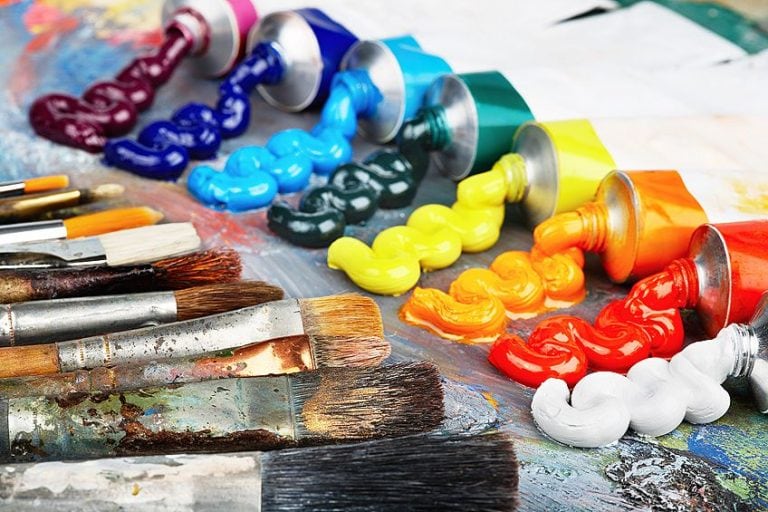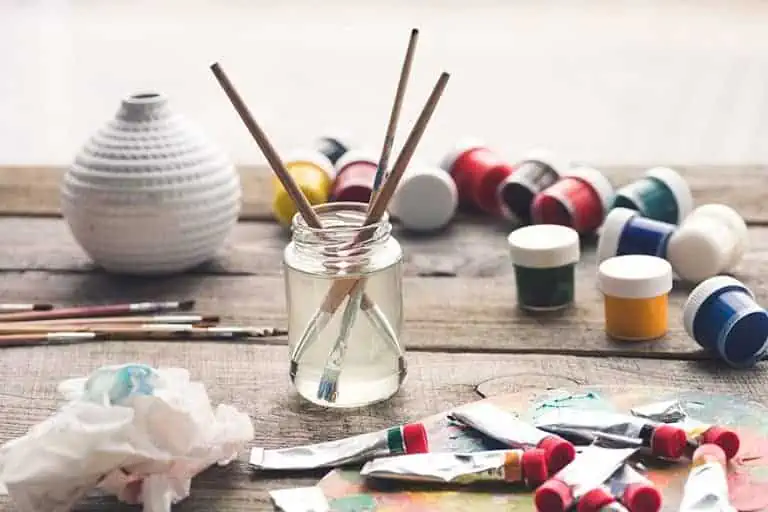Types of Paint Brushes for Acrylic Paint – Your Complete Guide
This post may contain affiliate links. We may earn a small commission from purchases made through them, at no additional cost to you.
Are you a novice when it comes to acrylic painting? Then you might be wondering what the different types of acrylic paint brushes are, and what acrylic paint brush sets you should be looking at? Well, if you are going to do something, and you want to do it well, you should get yourself good quality acrylic painting tools and that includes brushes. You will need to understand that the various types of paintbrushes provide a variety of effects. So, when you are learning different painting techniques with these brushes, you will be able to create unique art pieces and imagine even more than you thought possible.
Table of Contents
Types of Paint Brushes for Acrylic Paint
Besides the size and shape of a brush, which we will be going into detail about later, paintbrushes are made of different materials. The two main groups a brush can fall into are the natural bristles and the synthetic bristles.
Natural or Synthetic?
Natural bristles can be made from hogs’ hair or sable, where the hogs’ hair is usually stiff, and the sable is soft. You can also get camel hair brushes, which are generally not made from actual camel hair. These are mostly obtained from goats, ponies, ox, badgers, amongst others. These brushes are best used for painting with oils. This is because they can handle the heavy load of oil paints, and they also retain their shape and can be used multiple times.
However, when used with acrylic paints, the bristles can be damaged, and if the brushes remain in water too long, this can also negatively affect the natural bristles as they soak up the water. You can use natural brushes with acrylic paint; however, you must clean them thoroughly after you have used them. Also, if you have used the brushes with oil paint, the oil paint will need to be properly removed with turpentine before using it again with acrylics, as the oils will naturally repel the acrylic paint.

The best choice for acrylic paints would be a synthetic nylon brush. However, you also get polyester brushes and a combination of both materials. You can get a wide range of different synthetic brushes, from your stiff variety to the softer bristles. These brushes work well with acrylic paints and can easily be cleaned without harming the bristles. Synthetic brushes are, therefore, more durable and are much cheaper than your natural variety. One disadvantage is that the synthetic bristles can never be as soft as natural brushes and do not hold as much pigment as natural brushes can.
When you are looking at soft and stiff brushes, each one can provide different effects. Softer brushes provide a smoother application and can blend nicely. Stiff brushes provide more texture, as they will leave marks as you paint. As mentioned, oil paints are heavier and require thicker brushes, while watercolors need soft brushes.
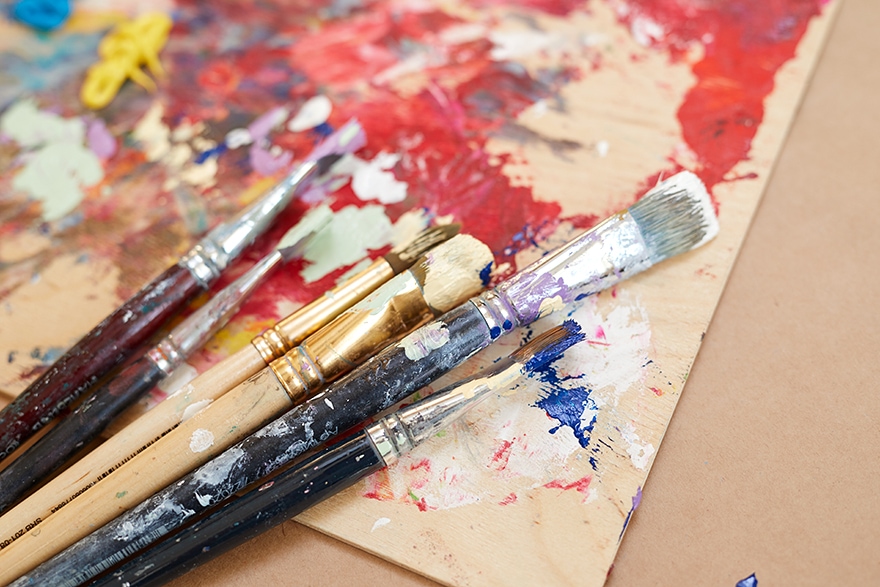
Acrylic paints fall somewhere in the middle of these two options, but it depends on the techniques used and the effects you want to achieve. Also, you do not want to use your expensive natural sable brush with acrylic paints. When using acrylics, brushes need to be in water a lot of the time, which will ruin the natural fibers quite quickly.
You should easily be able to find brushes for acrylic paint that have been specifically made for acrylics. You will find that these brushes are more durable and will keep their shape over time.
So, these are an excellent choice for those who are just starting to paint with acrylics. Below is a table that provides some of the different properties of each type of paintbrush.
| Natural Paintbrush | Synthetic Paintbrush | |
| Expensive | ✔ | ✘ |
| More Affordable | ✘ | ✔ |
| Oil-based Paints | ✔ | ✔ |
| Acrylic Paints | ✘ | ✔ |
| Bristle Loss | ✔ | ✘ |
| Cleans Easily | ✘ | ✔ |
| Durability | ✘ (needs more care) | ✔ |
| Smoother Strokes | ✘ | ✔ |
| Retains Stiffness With Acrylics | ✘ (loses stiffness over time) | ✔ |
A Closer Look at Paintbrushes
Since we are discussing paintbrushes, let us take a look at the actual design of a paintbrush. When looking at a brush, you have what is known as the toe end, which is where the bristles come into contact with the canvas. You get the entire head of the bristles, while the belly consists of the widest section of the bristle hairs.
You then get the ferrule, which is generally made out of metal, and this connects the bristles to the handle of the paintbrush. The crimp fastens the ferrule to the handle section. You also have the heel section of the ferrule, which is what squeezes the bristles and keeps them in place. Also, on the handle itself, you should be able to see the size of the brush and sometimes the style is also included.
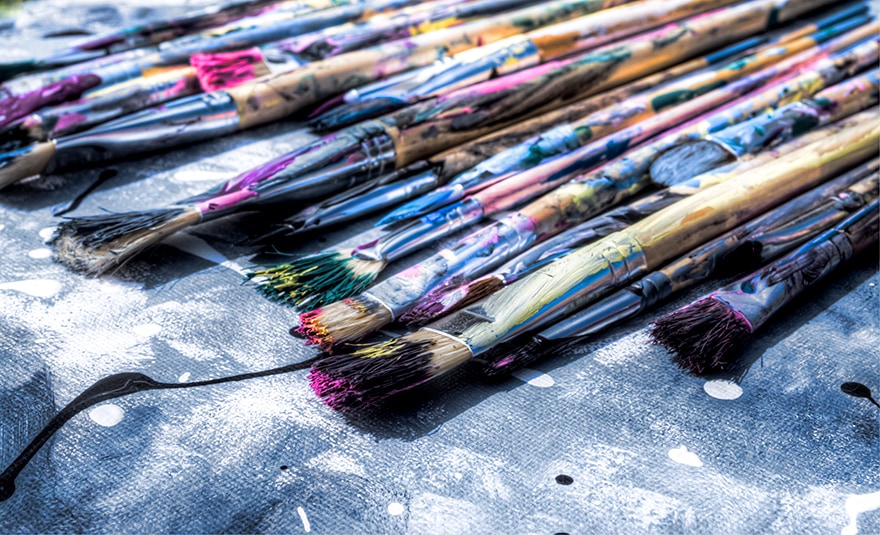
What to Consider When Purchasing Acrylic Paint Brush Sets
As a beginner working with acrylics, you do not require too many brushes. Rather, think about getting a few different sizes so that you can experiment and find what works best for you. Purchasing paintbrushes is also a personal thing, you might be quite happy working with cheaper varieties, while others prefer to purchase a collection of quality products.
So, we have already looked at synthetic versus natural brushes and found that the best and most affordable option would be a synthetic brush. However, there are other factors to take into consideration as well and these include the following.
The Paintbrush Size
Paintbrushes come in an assortment of sizes, from larger to smaller. The size brush you choose will be subject to what you are painting. Finer details need a small brush and if you want to cover larger areas, your brush will need to be bigger. Brush sizes come in a selection from 0000 up to twenty-four. Beginners can choose three sizes, one small, one mid-size, and another large-size brush. The various manufacturers of paintbrushes create different sizes for similar numbers. So, when purchasing online, make sure you check the measurements and not just the size of a brush.
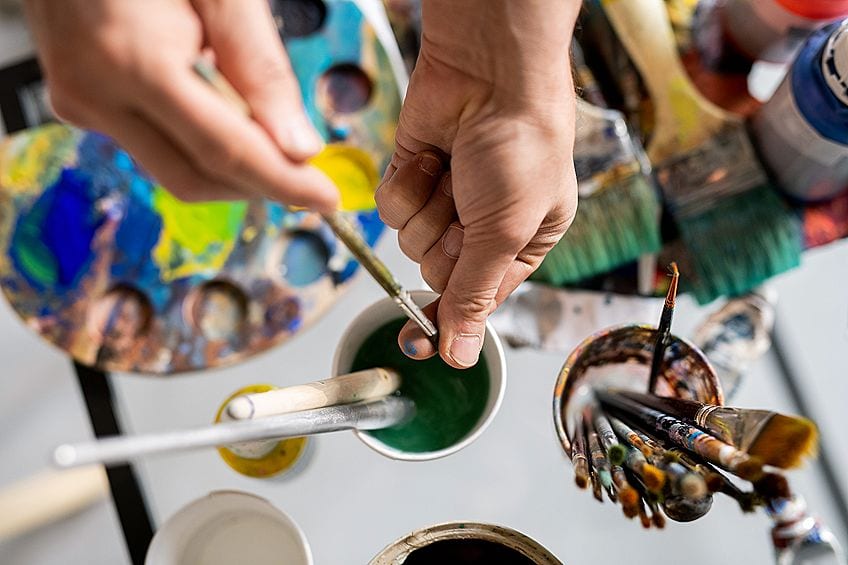
The Paintbrush Shape
Different brush shapes can provide varying effects and stroke patterns. You will need to experiment with the various shapes to discover the effect you want. The basic paintbrush shapes include round, flat, bright, fan, filbert, angle, mop, and rigger. See further below for more information and products on the types and shapes of paintbrushes.
Soft or Stiff Brushes?
Softer and stiffer bristles can offer different effects, softer brushes can successfully be used for blending. When attempting more abstract art, or painting pieces that require more texture, using stiff brushes might be what you are looking for.
Cost of Paintbrushes
Today, there are many brands available for you to choose from and your choice will, due to a large extent, be dependent on the price. If the cost does not matter, then you can choose the more upmarket varieties. However, there are more affordable options that offer similar results.
You might want to think about visiting an art store, where you can feel the different types of brushes for yourself. Once you discover what you want and need, you can then consider purchasing online in the future. When physically purchasing paintbrushes at the store, you can easily do a quality check before paying. When underpainting or applying large areas of paint, you can save money by purchasing a cheaper variety of brushes.
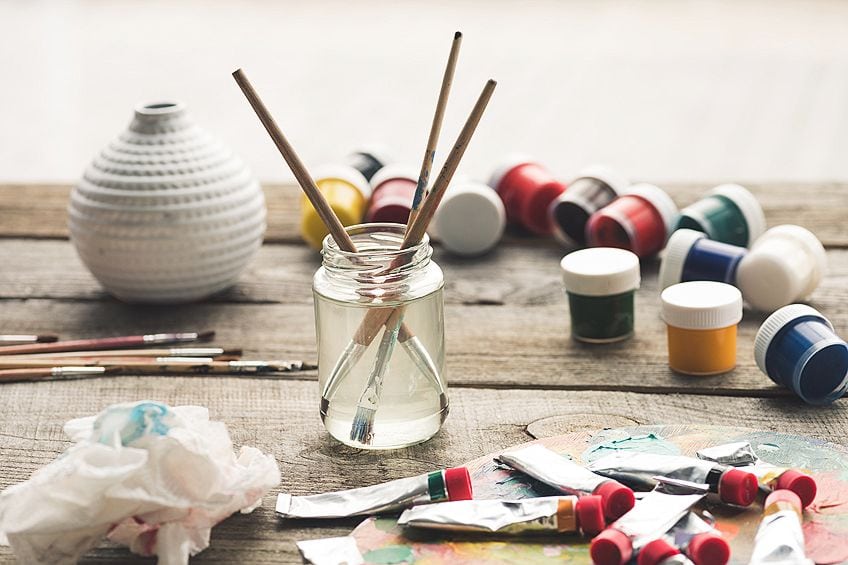
Different Types of Brushes for Acrylic Paint
Choosing the different types of paint brushes for acrylic painting may seem challenging, considering all that we have discussed so far. It may be hard to find the correct size, shape, and brand that is best for you. To help you understand the types of paint brushes for acrylic, here are their various common shapes and product recommendations for each.
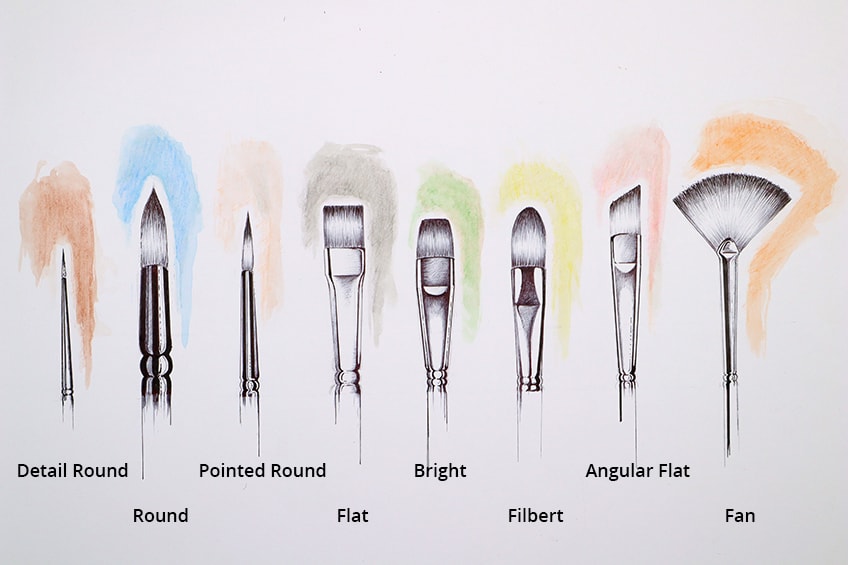
The Type of Handle
When considering the shape of your acrylic brushes, you also need to consider the length of the brush handle. Do you want the handle longer or do you prefer it shorter? Longer handles are great for applying paint when your canvas is on an easel and the length makes it easier to work with, providing more control. Shorter handles are best used on flat surfaces when the canvas is on a table.
Round Brushes for Acrylic Paint
The round bristle brushes taper off and form a point and are great to use for more detailed work. You can also use them to fill in smaller areas on your canvas and offer more control when painting finer details. The sizes of round brushes tend to be smaller when compared to the angle and flat brushes. You should experiment with these brushes for both dry and wet effects. You can also adjust the pressure when painting to produce thinner and thicker lines.
Fan Acrylic Brushes
Fan acrylic brushes are perfect for adding special effects as well as different textures. You can also use the brushes for blending, the hairs will fuse when you apply a little more pressure when painting. These brushes will work great for painting things like trees, grass, or other shrubs. You can imagine the shape by its name, providing a fan-shaped brush tip. The brush is also great for blending backgrounds. Different effects can be created by applying adjusted pressure, for example, tapping the brush or creating long strokes. The brushes can also be used for creating effects in your mixed-media art, adding texture and various designs.
Flat Acrylic Brushes
Flat brushes are perfect for spreading paint and will give you a wide wash and great coverage. You can also rotate the brush about ninety degrees for thinner lines. The tips of the brush are square-shaped; however, the volume is thin. Block in colors and create glazes with this brush. The flat brush is similar to a wash brush, but it is not as thick or rounded at the edges. The long bristles can be used for techniques such as impasto, and for creating bolder strokes. However, you can also use the edge to create finer lines if you wish. You also get the angle flat brushes, which you can read about further down.
Angle Acrylic Brushes
The angled brush will help you to feel more comfortable if you are working on an easel, it will give you more control over your movements. This paintbrush is a flat brush that is designed at an angle and may also be referred to as a chisel or slanted brush. The angle of the brush makes it easier to apply curves and can create clean lines and other shapes of varying thickness. You can paint some unusual textures, and the brush makes it easy to paint things like waves.
Liner or Rigger Acrylic Brushes
These brushes are long and form a fine point, providing smooth and precise lines. The brushes are perfect for finer details and very thin lines and can be used effectively with acrylic paint, or you can even use it with ink. The brush can also be used for creating letters and words on your page or canvas. Great for adding your signature to your artwork. The brushes can be worked when dry but produce better results when wet, as this helps with the flow of paint. These brushes are also commonly used for model or miniature painting.
Filberts Acrylic Brushes
This is a wide and round type of paintbrush, where the bristles are broader closer to the ferrule and forms a softer round top. These brushes are great for blending as well as for creating glazes. The brush is best used with a more low viscosity paint; however, you can get filbert brushes with stiff bristles. These are good to use for forming scumbles. The paintbrush usually has a thick ferrule, and the hairs are from medium to long and form a rounded, oval type shape. The filbert can be seen as in between a flat brush and a round brush.
Bright Acrylic Brushes
These brushes are good for painting things like flowers or landscapes and when pressed on the side, they can make bolder and broader strokes. You can also hold the brush more lightly, to create thinner lines. Dragging the brush across the canvas will help to create a sweeping effect and layer. A bright brush is almost like a flat brush; however, it has shorter bristles. You have more control over your painting; however, the brush will not hold as much paint and give shorter strokes.
Cleaning and Caring for Your Acrylic Brushes
Looking after paintbrushes is extremely important if you want them to last and do their job properly. This involves proper cleaning and storage of your paintbrushes. Any problems like bent bristles or dried paint can be avoided if you take the correct steps. Some professional paint brushes can cost a small fortune, so you want to make sure you do the right things to keep them in top shape.

Cleaning Acrylic Brushes
Never allow the paint to dry on your brushes. Once you have finished painting, try to remove any leftover paint from the brush. You can do this by rinsing the brush or wiping the brush with a cloth. When rinsing the brush, use some warm water in a bucket and rub the paint off the brush. If the paint has begun to dry, try using a stiff brush to loosen it. Wash again with some warm soap and water and rub the brush to remove the paint. You can use some artist soap when cleaning, which is both kind to the brushes and your hands. The soap is also good at helping to remove dried paint. We have a separate article about how to clean acrylic paint brushes.
Rinse the brush off in a clean bucket of water and shake off most of the water and leave to dry lying flat. When leaving a wet brush to dry standing up, the water could run down inside the ferrule, and this can loosen the glue, or it may even grow mold.
Storing Your Brushes
Once the brush has dried, you can store it laying it flat so that the bristles do not bend. Store in a dry and cool space, and not close to any heat sources. Consider storing the brushes inside a paintbrush roll, which can be made out of cotton. You also get wooden containers and canvas zipper bags for paintbrushes.
As mentioned, when working with acrylic paints, synthetic brushes are the best choice. Synthetic brushes are cheaper, and they are more durable. The natural fiber brushes are a bit more sensitive and require excellent care. Even if you are gentle with washing and store correctly, natural brushes can still easily become damaged. Before storing, reshape the brush hairs gently and when storing, make sure each brush has enough space. You do not want anything pressing down onto the brushes, causing damage.

Tips When Using Brushes for Acrylic Paint
There seems to be a lot to take in when considering the types of paint brushes for acrylic art. You have to understand the different brush sizes, types, and shapes, it can get a little complicated. Not only that, but once you have the paintbrushes, how do you take care of them? Here are some tips about the best acrylic paint brushes and what to look out for.
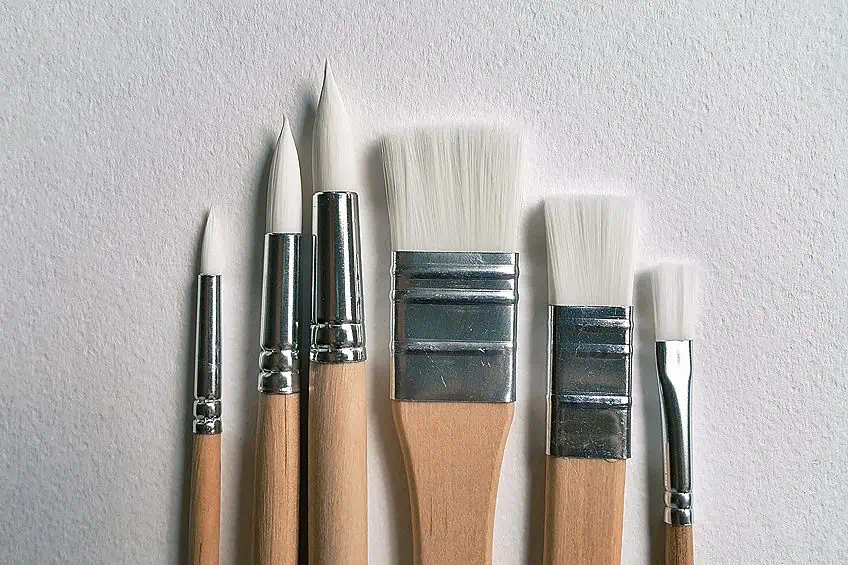
- Never let the paint dry on your acrylic brushes, it will ruin them
- Tyr using an artist soap for better results
- Always place the brushes flat on a surface when drying
- When you are busy painting, never leave a brush in water for long periods
- Once clean and dry, you can store your brushes lying flat or upright. Never place the brush with the bristles facing down. This will damage and bend the bristles
- Preferably, use synthetic brushes for acrylic painting
- Avoid buying the cheapest brushes you can find as these tend to shed hair and the bristles eventually separate when you are painting
- You only need a few brushes to start with, you do not have to go for a full set. Try getting a flat and oval top filbert brush that comes in a few different sizes, to begin with
- It is also good to have a finer brush as well as a large flat brush in your collection
- Once you have experimented and get a feel for the types of paint brushes for acrylic, you can increase your collection if you wish
- When painting, make sure to keep the brush moist at all times
- You can also use different size palette knives to mix and paint with. They are generally inexpensive, and you can create more textures and effects
- In place of the palette knife, a plastic knife can also work. You can also consider using an old credit card
- When painting, it is always a good idea to go for better quality brushes that can last longer. Also, you should purchase good quality acrylic paint so you can produce your best work
- Brushes with metal ferrules like nickel or aluminum, can offer better protection and make the brush more durable. These help to prevent the bristles from coming loose and shedding onto your artwork
Frequently Asked Questions
What Type of Brush Is Best For Acrylics?
The best brushes are synthetic bristle brushes as these are more durable and, in some cases, are designed specifically for acrylic paints. Many of the synthetic brushes today, can be used for acrylic paints, oil paints, and watercolors. You can use natural hair brushes; however, you will have to make sure you take extra good care of them when using, cleaning, and storing. Natural brushes are also a lot more expensive than synthetic paintbrushes.
What Are Synthetic Brushes Made From?
Synthetic paintbrushes are made from either nylon or polyester, and can also consist of a combination of these two materials.
How Can You Keep Your Acrylic Paintbrush Soft?
The trick is to keep the bristles moist while you are busy painting. Try to place the brushes lying horizontal to prevent any water from dripping down onto the ferrule and handle. Keeping them moist helps to prevent any paint from drying, especially if you cannot see any of the paint residues.
Is It Possible to Use Acrylic Brushes For Oil Painting?
In general, acrylic brushes can be used with oil paints and watercolors. However, brushes specifically designed for oil painting or watercolors, should not be used with acrylic paints.
In 2005, Charlene completed her wellness degrees in therapeutic aromatherapy and reflexology at the International School of Reflexology and Meridian Therapy. She worked for a company offering corporate wellness programs for several years before opening her own therapy practice. In 2015, she was asked by a digital marketer friend to join her company as a content creator, and it was here that she discovered her enthusiasm for writing. Since entering the world of content creation, she has gained a lot of experience over the years writing about various topics such as beauty, health, wellness, travel, crafting, and much more. Due to various circumstances, she had to give up her therapy practice and now works as a freelance writer. Since she is a very creative person and as a balance to writing likes to be active in various areas of art and crafts, the activity at acrylgiessen.com is perfect for her to contribute their knowledge and experience in various creative topics.
Learn more about Charlene Lewis and about us.


